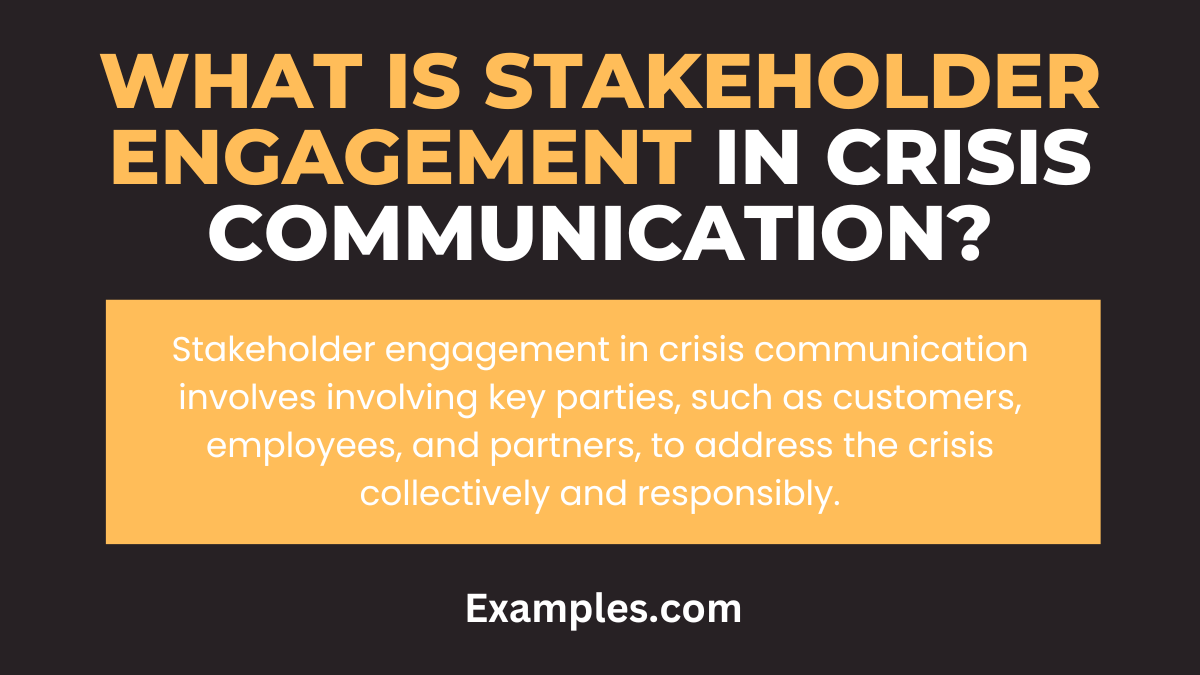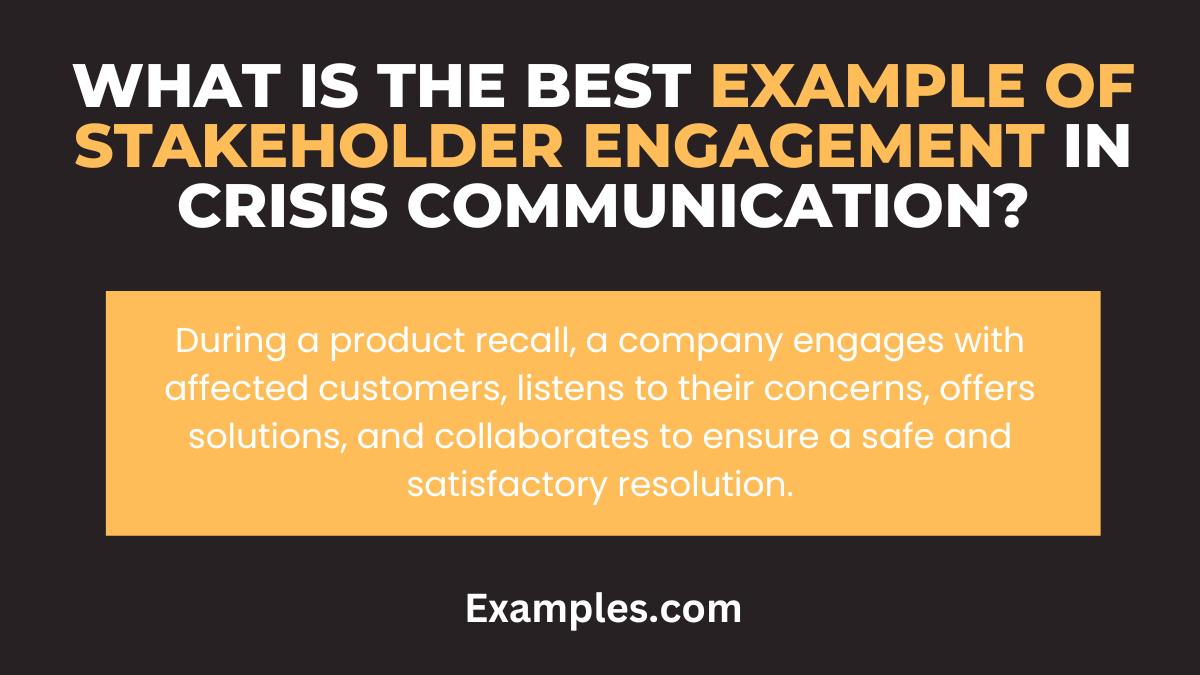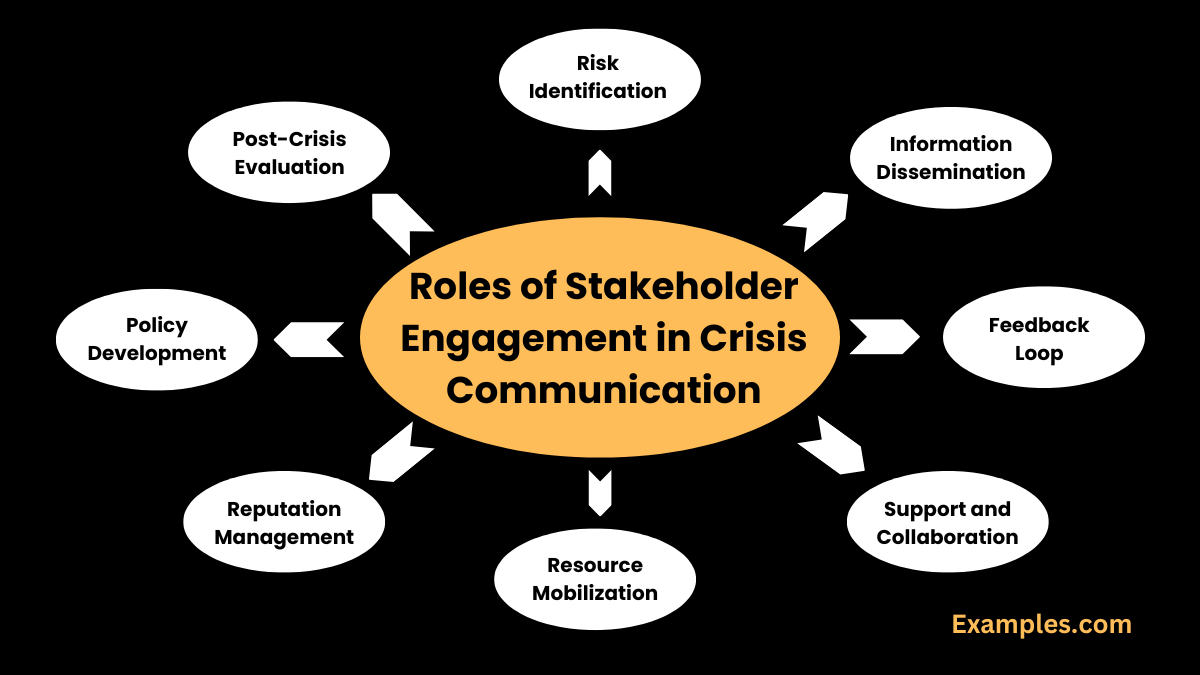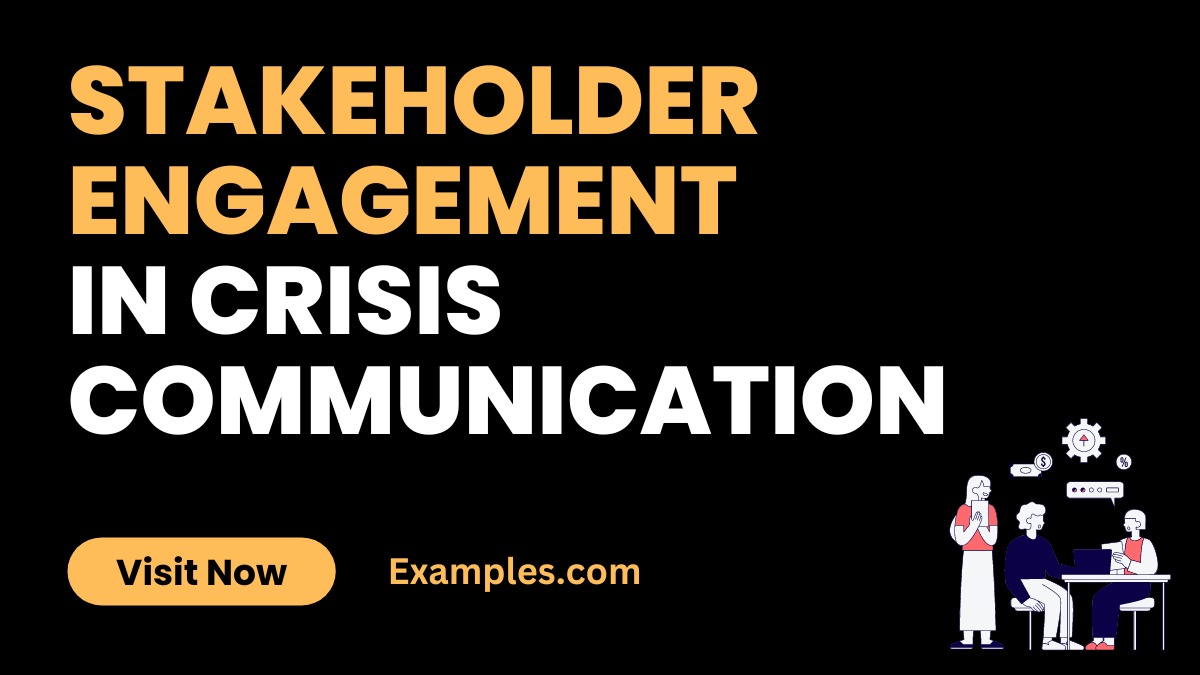19+ Stakeholder Engagement in Crisis Communication Examples
In the realm of Crisis Communication, effective stakeholder engagement is pivotal. This comprehensive guide delves into the nuances of maintaining robust communication lines during crises. By weaving in real-world examples, it emphasizes the importance of strategic planning and empathetic dialogue. Understanding stakeholder engagement can be the difference between escalating a crisis and successfully navigating it. This guide offers practical steps and insights into building trust and maintaining clear communication channels, ensuring your message is received accurately and positively.
What is Stakeholder Engagement in Crisis Communication?

Stakeholder Engagement in Crisis Communication refers to the systematic approach of communicating with, and involving, various stakeholders during a crisis situation. It’s about ensuring that all parties, from employees to customers, and the media, are kept informed and engaged. This engagement is crucial for managing perceptions, maintaining trust, and ensuring transparent communication throughout the crisis lifecycle.
What is the Best Example of Stakeholder Engagement in Crisis Communication?

One notable example of Stakeholder Engagement in Crisis Communication is the response to the 9/11 attacks by various organizations. Here, the focus was on rapid, transparent, and empathetic communication. Organizations not only communicated effectively with their employees and stakeholders but also collaborated with external agencies for a unified response. This example showcases how timely information dissemination, empathy, and collaborative efforts can effectively manage a crisis, maintain trust, and reduce panic and misinformation.
20 Examples of Stakeholder Engagement in Crisis Communication
Stakeholder engagement is crucial in effective crisis communication. This compilation showcases 20 distinct examples of how organizations can effectively communicate with stakeholders during crises. These examples emphasize the Importance of Crisis Communication and Stakeholder Engagement in Crisis Communication, providing strategies and key sentences to navigate complex situations. Each example illustrates a unique approach to maintaining trust and transparency in challenging times.
- Rapid Response to Customer Inquiries: Prioritize swift responses to customer concerns during a crisis.
Example: “We’re actively addressing the issue and will keep you updated.” - Transparent Updates to Investors: Regular, honest updates to investors build trust.
Example: “We’re transparently sharing our steps towards resolving the current challenge.” - Consistent Internal Communication: Keep employees informed with consistent messaging.
Example: “Our team is our strength; we’re in this together and will keep everyone updated.” - Engaging with Media for Accurate Reporting: Proactive media engagement ensures accurate information dissemination.
Example: “We’re committed to providing factual updates through our official channels.” - Monitoring Social Media for Public Sentiment: Monitor social media to understand public perception and respond appropriately. Example: “We value your opinions and are listening to your concerns on social platforms.”
- Empathetic Responses to Public Outcry: Show empathy in public responses to maintain a positive image.
Example: “We understand your concerns and are working tirelessly to resolve the situation.” - Factual Updates to Regulatory Bodies: Keep regulatory bodies informed with accurate, timely information.
Example: “We’re committed to compliance and will keep you informed of our progress.” - Preparedness Communications with Local Communities: Engage local communities with preparedness plans.
Example: “Your safety is our priority; here’s how we’re preparing for potential scenarios.” - Post-Crisis Evaluation Reports to Stakeholders: Share learnings and improvements post-crisis.
Example: “We’ve learned from this experience and are implementing these changes…” - Proactive Updates to Clients: Keep clients informed before they need to ask.
Example: “We’re proactively addressing the issue and will ensure minimal impact on our services.” - Reactive Statements to Unforeseen Events: Quickly address unforeseen events to mitigate impact.
Example: “We’re aware of the situation and are actively working on a solution.” - Instructional Communication for Safety Procedures: Clearly instruct stakeholders on safety procedures during crises.
Example: “Please follow these steps to ensure your safety…” - Adjustment Announcements to Business Partners: Inform partners of any operational adjustments.
Example: “We’re adjusting our operations and will coordinate closely with you.” - Reputation Management with Industry Analysts: Engage with analysts to maintain a positive industry reputation.
Example: “We’re committed to upholding our standards and will keep you informed.” - Internal Crisis Updates in Town Hall Meetings: Use town hall meetings for comprehensive internal crisis communication.
Example: “We value your input and dedication during these challenging times.” - External Communication on Environmental Impact: Communicate externally about environmental impacts and mitigation steps. Example: “We’re responsible for our environmental impact and here’s our action plan.”
- Social Media Statements during Crisis: Use social media for timely, widespread communication.
Example: “For immediate updates, follow our official social media channels.” - Stakeholder-Specific Emails on Progress: Tailor communication to specific stakeholder needs.
Example: “We understand your unique concerns and here’s our specific plan for you.” - Post-Crisis Follow-Up and Feedback: Engage stakeholders post-crisis for feedback and improvement.
Example: “Your feedback is valuable in improving our crisis management strategies.” - Crisis Management Plan Updates to All Stakeholders: Keep stakeholders informed of any updates to the crisis management plan. Example: “We’ve updated our crisis management plan; here are the key changes…”
Importance of Stakeholder Engagement in Crisis Communication
- Enhances Transparency: Stakeholder engagement in crisis communication fosters transparency, building trust and credibility among all parties involved.
- Facilitates Rapid Response: Engaging stakeholders ensures quick dissemination of information, aiding in the effective and timely management of the crisis.
- Improves Decision Making: Involvement of diverse stakeholders offers multiple perspectives, leading to more informed and effective decision-making.
- Strengthens Relationships: Regular engagement with stakeholders strengthens relationships, crucial for gaining support during a crisis.
- Boosts Public Image: Active stakeholder engagement enhances an organization’s public image, showcasing its commitment to open communication and responsibility.
- Increases Effectiveness of Communication: Tailored communication strategies to meet the needs of different stakeholders result in more effective crisis communication.
- Mitigates Risks: Early stakeholder engagement can help in identifying potential risks and developing strategies to mitigate them.
- Ensures Long-Term Success: Ongoing engagement with stakeholders contributes to the long-term success and resilience of an organization post-crisis.
What are the Roles of Stakeholder Engagement in Crisis Communication?

- Risk Identification and Management: Stakeholders play a crucial role in identifying and managing risks associated with a crisis.
- Information Dissemination: They assist in the effective dissemination of information to the public and other relevant parties.
- Feedback Loop: Stakeholders provide valuable feedback, enabling organizations to adjust their communication strategies accordingly.
- Support and Collaboration: They offer support and collaboration, crucial for crisis resolution and recovery efforts.
- Resource Mobilization: Stakeholders can mobilize resources, both material and informational, essential during a crisis.
- Reputation Management: Their involvement is key in managing and maintaining the organization’s reputation during and after a crisis.
- Policy Development: Stakeholders contribute to the development of policies and procedures for effective crisis management.
- Post-Crisis Evaluation: They play a significant role in the post-crisis evaluation, helping to identify lessons learned and areas for improvement.
Aspects of Stakeholder Engagement in Crisis Communication
- Identification of Key Stakeholders: Recognizing who the key stakeholders are and understanding their concerns and expectations.
- Communication Channels: Establishing effective channels of communication tailored to different stakeholder groups.
- Regular Updates: Providing stakeholders with regular updates about the crisis and the steps being taken to address it.
- Stakeholder Feedback: Actively seeking and incorporating feedback from stakeholders into the crisis management process.
- Cultural Sensitivity: Being culturally sensitive in communication to cater to the diverse backgrounds of stakeholders.
- Transparency: Maintaining transparency throughout the crisis communication process to build and sustain trust.
- Training and Preparedness: Training stakeholders in crisis communication and preparedness to ensure a coordinated response.
- Long-Term Engagement: Ensuring long-term engagement with stakeholders, not just during a crisis but as part of regular operations.
In conclusion, effective Stakeholder Engagement in Crisis Communication is pivotal for managing crises efficiently. It ensures transparent, rapid, and informed responses, reinforcing trust and credibility. Adopting tailored strategies for stakeholder engagement, organizations can significantly enhance their crisis management capabilities, safeguarding their reputation and ensuring long-term success.



